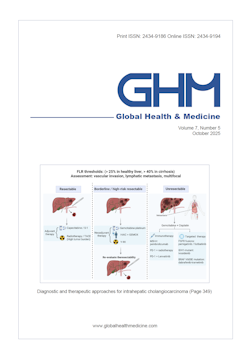Global Health & Medicine 2023;5(1):47-53.
High-flow nasal cannula for severe COVID-19 patients in a Japanese single-center, retrospective, observational study: 1 year of clinical experience
Katsuno T, Suzuki M, Morishita M, Kawajiri K, Saito S, Horikawa Y, Ueki Y, Yamaguchi Y, Takumida H, Watanabe H, Morita C, Tsukada A, Kusaba Y, Tsujimoto Y, Ishida A, Sakamoto K, Hashimoto M, Terada J, Takasaki J, Izumi S, Hojo M, Sugiyama H
High-flow nasal cannula (HFNC) can be effective in treating type 1 respiratory failure by reducing the severity of coronavirus disease 2019 (COVID-19). The purpose of this study was to assess the reduction of disease severity and safety of HFNC treatment in patients with severe COVID-19. We retrospectively observed 513 consecutive patients with COVID-19 admitted to our hospital from January 2020 to January 2021. We included patients with severe COVID-19 who received HFNC for their deteriorating respiratory status. HFNC success was defined as improvement in respiratory status after HFNC and transfer to conventional oxygen therapy, while HFNC failure was defined as transfer to non‐invasive positive pressure ventilation or ventilator, or death after HFNC. Predictive factors associated with failure to prevent severe disease were identified. Thirty-eight patients received HFNC. Twenty-five (65.8%) patients were classified in the HFNC success group. In the univariate analysis, age, history of chronic kidney disease (CKD), non-respiratory sequential organ failure assessment (SOFA) ≥ 1, oxygen saturation to fraction of inspired oxygen ratio (SpO2/FiO2) before HFNC ≤ 169.2, were significant predictors of HFNC failure. Multivariate analysis revealed that SpO2/FiO2 value before HFNC ≤ 169.2 was an independent predictor of HFNC failure. No apparent nosocomial infection occurred during the study period. Appropriate use of HFNC for acute respiratory failure caused by COVID-19 can reduce the severity of severe disease without causing nosocomial infection. Age, history of CKD, nonrespiratory SOFA before HFNC ≤ 1, and SpO2/FiO2 before HFNC ≤ 169.2 were associated with HFNC failure.
DOI: 10.35772/ghm.2022.01054







